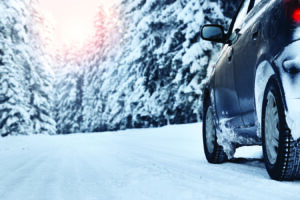Drive Safely in Winter Weather: It’s the Law


Slowing down and taking extra time on your winter commute may make all the difference.
Winter is here – along with storms, snow and freezing temperatures. Unfortunately, bad weather also means more collisions, injuries, and even deaths on the roads. While winter weather makes driving more dangerous, we all have a duty to adapt and drive in a way that is “reasonable and prudent under the conditions and having regard to the actual and potential hazards […].” Simple steps can help prevent crashes and protect you and your loved ones from other careless drivers.
Fully De-Ice Your Windshield Before You Go
Winter weather interferes with the ability to see and be seen on the road, which are key for safe driving. While it can be a hassle to scrape off a thick coat of ice on our windshield, driving without adequately clearing your windshield is both dangerous and illegal. During the winter, plan ahead to give yourself time to warm up and defrost the car, and make sure you have a heavy-duty ice scraper.
Use Headlights When You Use Windshield Wipers
Under Washington law, headlights are required to be on from a half hour after sunset until a half hour before sunrise – in addition to any other time that weather or conditions make it hard to see. A good rule of thumb is to have your headlights on anytime your windshield wipers are on. Because of the weather and increased darkness, now is a good time to check your vehicle head and taillights to ensure that they are all in working condition and clearly visible.
Drive Slowly Enough to React Safely
Winter weather also plays a role in safe speeds and stopping distances. Ice, snow, or even rainwater on the roadway increases the amount of time needed to safely to stop or slow cars in the event of an emergency. Other drivers failing to maintain safe speeds for winter conditions often cause spinouts or pileup crashes if drivers do not leave enough space to react. Under Washington law, drivers are responsible for maintaining enough distance to safely react to car they are behind, especially when the roads are wet or icy.
Allow Extra Time, Check the Forecast, and Stock Up Your Vehicle
Finally, give yourself extra time to travel in the winter. If traveling out of town, check the weather on major mountain passes at WSDOT.wa.gov. Always carry appropriate chains for your tires and practice installing them – before you’re stuck in the snow. Studded snow tires are permitted in Washington from November 1 through March 31. It may take hours to clear winter weather pileups, especially along rural highways, so stock your vehicle with clothing, food, and water for road trips.
You’re Responsible for Adjusting to Changing Winter Driving Conditions
With winter comes hazardous road conditions. Under Washington law it is the driver’s responsibility to adjust their driving accordingly. By slowing down, planning, and taking simple precautions, we can all help each other get home safely this winter. However, if you or a family member is injured by another driver failing to drive safely for the weather, call the attorneys at Abeyta Nelson Injury Law to discuss your case.
-blog written by attorney James M. Boyer, Abeyta Nelson Injury Law